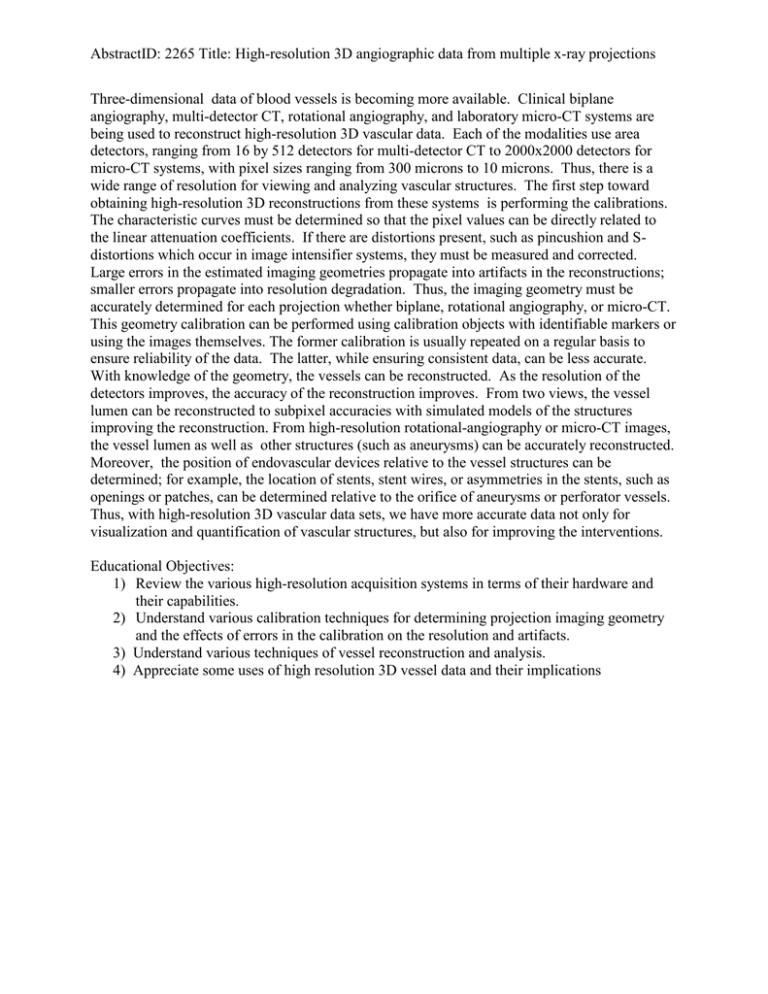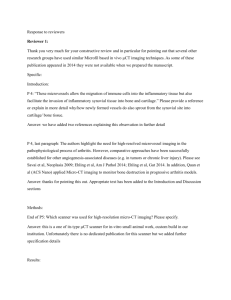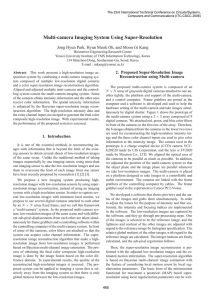AbstractID: 2265 Title: High-resolution 3D angiographic data from multiple x-ray... Three-dimensional data of blood vessels is becoming more available. ...
advertisement

AbstractID: 2265 Title: High-resolution 3D angiographic data from multiple x-ray projections Three-dimensional data of blood vessels is becoming more available. Clinical biplane angiography, multi-detector CT, rotational angiography, and laboratory micro-CT systems are being used to reconstruct high-resolution 3D vascular data. Each of the modalities use area detectors, ranging from 16 by 512 detectors for multi-detector CT to 2000x2000 detectors for micro-CT systems, with pixel sizes ranging from 300 microns to 10 microns. Thus, there is a wide range of resolution for viewing and analyzing vascular structures. The first step toward obtaining high-resolution 3D reconstructions from these systems is performing the calibrations. The characteristic curves must be determined so that the pixel values can be directly related to the linear attenuation coefficients. If there are distortions present, such as pincushion and Sdistortions which occur in image intensifier systems, they must be measured and corrected. Large errors in the estimated imaging geometries propagate into artifacts in the reconstructions; smaller errors propagate into resolution degradation. Thus, the imaging geometry must be accurately determined for each projection whether biplane, rotational angiography, or micro-CT. This geometry calibration can be performed using calibration objects with identifiable markers or using the images themselves. The former calibration is usually repeated on a regular basis to ensure reliability of the data. The latter, while ensuring consistent data, can be less accurate. With knowledge of the geometry, the vessels can be reconstructed. As the resolution of the detectors improves, the accuracy of the reconstruction improves. From two views, the vessel lumen can be reconstructed to subpixel accuracies with simulated models of the structures improving the reconstruction. From high-resolution rotational-angiography or micro-CT images, the vessel lumen as well as other structures (such as aneurysms) can be accurately reconstructed. Moreover, the position of endovascular devices relative to the vessel structures can be determined; for example, the location of stents, stent wires, or asymmetries in the stents, such as openings or patches, can be determined relative to the orifice of aneurysms or perforator vessels. Thus, with high-resolution 3D vascular data sets, we have more accurate data not only for visualization and quantification of vascular structures, but also for improving the interventions. Educational Objectives: 1) Review the various high-resolution acquisition systems in terms of their hardware and their capabilities. 2) Understand various calibration techniques for determining projection imaging geometry and the effects of errors in the calibration on the resolution and artifacts. 3) Understand various techniques of vessel reconstruction and analysis. 4) Appreciate some uses of high resolution 3D vessel data and their implications

![hpkaG ]_Z[G {aG z G G Tj{G G G Tj{G](http://s2.studylib.net/store/data/014743219_1-8112dde1e1caa026ad806b3d158c404e-300x300.png)



